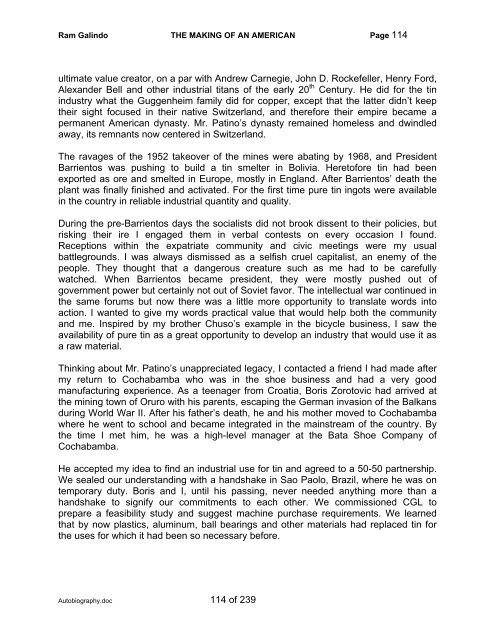Autobiography - The Galindo Group
Autobiography - The Galindo Group
Autobiography - The Galindo Group
Create successful ePaper yourself
Turn your PDF publications into a flip-book with our unique Google optimized e-Paper software.
Ram <strong>Galindo</strong> THE MAKING OF AN AMERICAN Page 114<br />
ultimate value creator, on a par with Andrew Carnegie, John D. Rockefeller, Henry Ford,<br />
Alexander Bell and other industrial titans of the early 20 th Century. He did for the tin<br />
industry what the Guggenheim family did for copper, except that the latter didn’t keep<br />
their sight focused in their native Switzerland, and therefore their empire became a<br />
permanent American dynasty. Mr. Patino’s dynasty remained homeless and dwindled<br />
away, its remnants now centered in Switzerland.<br />
<strong>The</strong> ravages of the 1952 takeover of the mines were abating by 1968, and President<br />
Barrientos was pushing to build a tin smelter in Bolivia. Heretofore tin had been<br />
exported as ore and smelted in Europe, mostly in England. After Barrientos’ death the<br />
plant was finally finished and activated. For the first time pure tin ingots were available<br />
in the country in reliable industrial quantity and quality.<br />
During the pre-Barrientos days the socialists did not brook dissent to their policies, but<br />
risking their ire I engaged them in verbal contests on every occasion I found.<br />
Receptions within the expatriate community and civic meetings were my usual<br />
battlegrounds. I was always dismissed as a selfish cruel capitalist, an enemy of the<br />
people. <strong>The</strong>y thought that a dangerous creature such as me had to be carefully<br />
watched. When Barrientos became president, they were mostly pushed out of<br />
government power but certainly not out of Soviet favor. <strong>The</strong> intellectual war continued in<br />
the same forums but now there was a little more opportunity to translate words into<br />
action. I wanted to give my words practical value that would help both the community<br />
and me. Inspired by my brother Chuso’s example in the bicycle business, I saw the<br />
availability of pure tin as a great opportunity to develop an industry that would use it as<br />
a raw material.<br />
Thinking about Mr. Patino’s unappreciated legacy, I contacted a friend I had made after<br />
my return to Cochabamba who was in the shoe business and had a very good<br />
manufacturing experience. As a teenager from Croatia, Boris Zorotovic had arrived at<br />
the mining town of Oruro with his parents, escaping the German invasion of the Balkans<br />
during World War II. After his father’s death, he and his mother moved to Cochabamba<br />
where he went to school and became integrated in the mainstream of the country. By<br />
the time I met him, he was a high-level manager at the Bata Shoe Company of<br />
Cochabamba.<br />
He accepted my idea to find an industrial use for tin and agreed to a 50-50 partnership.<br />
We sealed our understanding with a handshake in Sao Paolo, Brazil, where he was on<br />
temporary duty. Boris and I, until his passing, never needed anything more than a<br />
handshake to signify our commitments to each other. We commissioned CGL to<br />
prepare a feasibility study and suggest machine purchase requirements. We learned<br />
that by now plastics, aluminum, ball bearings and other materials had replaced tin for<br />
the uses for which it had been so necessary before.<br />
<strong>Autobiography</strong>.doc 114 of 239


